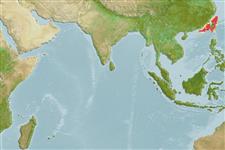Elasmobranchii (Haie und Rochen) (sharks and rays) >
Orectolobiformes (Carpet sharks) >
Parascylliidae (Collared carpet sharks)
Etymology: Cirrhoscyllium: cirrus, Latin for curl or tendril, referring to barbels on throat; skylion, Greek for dogfish or small shark (See ETYFish); formosanum: -anum, Latin adjectival suffix that means, when attached to a name, “belonging to,” referring to its distribution off the coast of Formosa (Taiwan) (See ETYFish).
Environment: milieu / climate zone / Tiefenbereich / distribution range
Ökologie
seewasser demersal; tiefenbereich 110 - 320 m (Ref. 106604). Subtropical; 28°N - 21°N, 115°E - 123°E
Northwest Pacific: Taiwan.
Size / Gewicht / Alter
Geschlechtsreife: Lm ? range ? - ? cm
Max length : 39.0 cm TL Männchen/unbestimmt; (Ref. 247)
Found on the insular shelf. Oviparous (Ref. 50449).
Life cycle and mating behavior
Geschlechtsreife | Fortpflanzung | Ablaichen | Eier | Fecundity | Larven
Oviparous, paired eggs are laid. Embryos feed solely on yolk (Ref. 50449).
Compagno, L.J.V., 1984. FAO Species Catalogue. Vol. 4. Sharks of the world. An annotated and illustrated catalogue of shark species known to date. Part 1 - Hexanchiformes to Lamniformes. FAO Fish. Synop. 125(4/1):1-249. Rome, FAO. (Ref. 247)
IUCN Rote Liste Status (Ref. 130435: Version 2025-1)
Bedrohung für Menschen
Harmless
Nutzung durch Menschen
Fischereien: nicht kommerziell
Tools
Zusatzinformationen
Download XML
Internet Quellen
Estimates based on models
Phylogenetic diversity index (Ref.
82804): PD
50 = 0.6289 [Uniqueness, from 0.5 = low to 2.0 = high].
Bayesian length-weight: a=0.00389 (0.00180 - 0.00842), b=3.12 (2.94 - 3.30), in cm total length, based on all LWR estimates for this body shape (Ref.
93245).
Trophic level (Ref.
69278): 3.6 ±0.5 se; based on size and trophs of closest relatives
Widerstandsfähigkeit (Ref.
120179): niedrig, Verdopplung der Population dauert 4,5 - 14 Jahre. (Fec assumed to be <100).
Fishing Vulnerability (Ref.
59153): Low to moderate vulnerability (29 of 100).
🛈
